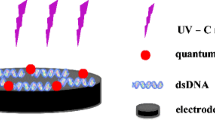Abstract
Halogenated phenols are widely used as biocides and are considered to be possibly carcinogenic to humans. In this report, a previously developed photoelectrochemical DNA sensor was employed to investigate DNA damage induced by tetra-halogenated quinones, the in vivo metabolites of halogenated phenols. The sensor surface was composed of a double-stranded DNA film assembled on a SnO2 semiconductor electrode. A DNA intercalator, Ru(bpy)2(dppz)2+, was allowed to bind to the DNA film and produce photocurrent upon light irradiation. After the DNA film was exposed to 300 μM tetrafluoro-1,4-benzoquinone (TFBQ), the photocurrent dropped by 20%. In a mixture of 300 μM TFBQ and 2 mM H2O2, the signal dropped by 40%. The signal reduction indicates less binding of Ru(bpy)2(dppz)2+ due to structural damage of ds-DNA in the film. Similar results were obtained with tetra-1,4-chlorobenzoquinone (TCBQ), although the signal was not reduced as much as TFBQ. Fluorescence measurement showed that TFBQ/H2O2 generated more hydroxyl radicals than TCBQ/H2O2. Gel electrophoresis proved that the two benzoquinones produced DNA strand breaks together with H2O2, but not by themselves. Using the photoelectrochemical sensor, it was also found that TCBQ covalently bound with DNA did not produce additional oxidative damage in the presence of H2O2. The combined photoelectrochemistry, gel electrophoresis, and fluorescence data revealed distinctive differences between TFBQ and TCBQ in terms of DNA adduct formation and hydroxyl radical generation.






Similar content being viewed by others
References
Ahlborg UG, Thunberg T (1980) Crit Rev Toxicol 7:1–35
Ramamoorthy S, Ramamoorthy S (1997) Chlorinated organic compounds in the environment. CRC, Boca Raton
Environmental Protection Agency Working Group (1980) Ambient water quality criteria for chlorinated phenols. Environmental Protection Agency, Washington DC
International Agency for Research on Cancer (1991) France, Lyon
Seiler JP (1991) Mutat Res 257:27–47
Sackmauerova-Veningerova M, Uhnak J, Szokolay A, Kocan A (1981) J Chromatogr 205:194–198
Tsai CH, Lin PH, Waidyanatha S, Rappaport SM (2001) Chem Biol Interact 134:55–71
Lin P-H, Nakamura J, Yamaguchi S, Upton PB, La DK, Swenberg JA (2001) Carcinogenesis 22:627–634
Lin P-H, Nakamura J, Yamaguchi S, La DK, Upton PB, Swenberg JA (2001) Carcinogenesis 22:635–639
Lin P-H, La DK, Upton PB, Swenberg JA (2002) Carcinogenesis 23:365–369
Nguyen TN, Bertagnolli AB, Villalta PW, Buhlmann P, Sturla SJ (2005) Chem Res Toxicol 18:1770–1776
Dai J, Sloat AL, Wright MW, Manderville RA (2005) Chem Res Toxicol 18:771–779
Zhu B-Z, Kitrossky N, Chevion M (2000) Biochem Biophys Res Commun 270:942–946
Zhu B-Z, Zhao HT, Kalyanaraman B, Frei B (2002) Free Radic Biol Med 32:465–473
Zhu B-Z, Kalyanaraman B, Jiang G-B (2007) Proc Natl Acad Sci USA 104:17575–17578
Carrizo D, Grimalt JO, Fito NR, Torrent M, Sunyer J (2008) Ecotoxicol Environ Saf 71:260–266
Choi SH, Gu MB (2003) Anal Chim Acta 481:229–238
Chen J, Jiang J, Zhang F, Yu H, Zhang J (2004) Cell Boil Toxicol 20:183–196
Vaidyanathan VG, Villalta PW, Sturla SJ (2007) Chem Res Toxicol 20:913–919
Pfeifer GP (1996) Technologies for detection of DNA damage and mutations. Plenum, New York
Liang MM, Guo L-H (2007) Environ Sci Technol 41:658–664
Jia SP, Liang MM, Guo L-H (2008) J Phys Chem B 112:4461–4464
Liang MM, Jia SP, Zhu S-C, Guo L-H (2008) Environ Sci Technol 42:635–639
Musumeci S, Rizzarelli FS, Sammartano S, Bonomo RP (1973) Inorg Chim Acta 7:660–662
Edmond A, Abdulrazzak H (1990) J Chem Soc Dalton Trans 1841–1845
Valko M, Morris H, Cronin MTD (2005) Curr Med Chem 12:1161–1208
Wei MY, Guo L-H, Chen H (2006) Microchim Acta 155:409–414
Halliwell B, Gutteridge JMC (2007) Free radicals in biology and medicine. Oxford Univ, New York
Manevich Y, Held KD, Biaglow JE (1997) Radia Res 148:580–591
Makrigiorgos GM, Baranowska-Kortylewicz J, Bump E, Sahu SK, Berman RM, Kassis AI (1995) Free Radic Biol Med 18:669–678
Acknowledgment
This work was supported by the National Natural Science Foundation of China (grant number 20825519, 20921063, 20890112) and the National Hi-Tech Research and Development Program of China (2006AA06Z422).
Author information
Authors and Affiliations
Corresponding author
Rights and permissions
About this article
Cite this article
Jia, S., Zhu, BZ. & Guo, LH. Detection and mechanistic investigation of halogenated benzoquinone induced DNA damage by photoelectrochemical DNA sensor. Anal Bioanal Chem 397, 2395–2400 (2010). https://doi.org/10.1007/s00216-010-3796-3
Received:
Revised:
Accepted:
Published:
Issue Date:
DOI: https://doi.org/10.1007/s00216-010-3796-3




